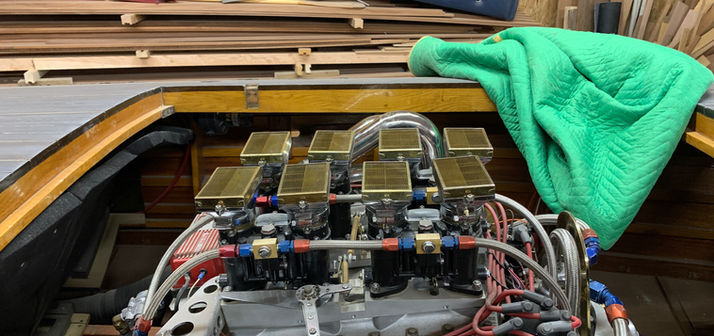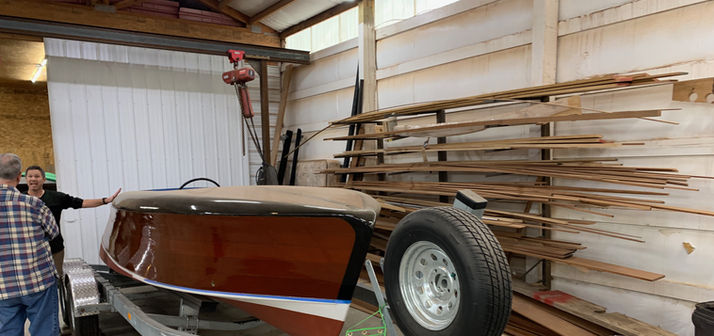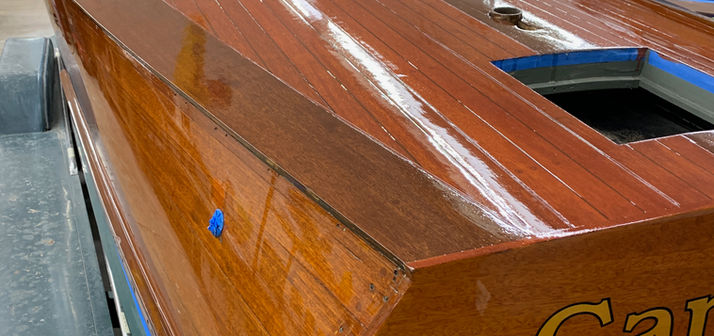


by Alan Wardsworth compliments of ADW Photography
The boats in the masthead is from the Sandpoint Boat Show where photographer Steve Lapkin spent the morning taking pictures on the lake of everyones boats which he has made available on his website.
2025 Chapter Officers
President: Steve Zwarg
Past President: Ron Yandt
Vice President: Bob Henshaw
Treasurer: Dick Winn
Secretary: Liz Wardsworth
Membership: Petyr Beck
Board Of Directors
Doug Brooke
BK Powell
Tim Murphy
Sheila Schaich
Mitch Johnson
------------------------------
Scuttlebutt/Webmaster:
Alan Wardsworth
Activity Chair: Paul Rodkey
Sponsorship Chair:
Tim Murphy
Sheila Schaich
Message from the President
My goals as your President is to improve communication to our members and to have more activities to use our boats and have some fun. The Board has seriously taken steps to get our website working as a tool for the club. The fun part this season is to setup dates for all three boat shows that we sponsor. In addition, we have planned four 4 other events starting with the Spokane Boat Show in January. Next, there will be 3 Boats and Brew(ed) garage tours in Feb-April. Then we will have a Show & Shine in late June. This is a tune up for the Spokane Boat Show and Whitefish Woody Weekend. There will be lots of other events to use your boat and meet other chapter members. So get your boat shined up and ready to go for 2025.
Happy Boating,
Steve Zwrg


Our Mission:
To bring people together with a common interest in historic, antique, and classic boats, sharing fellowship, information, experience, and exchange of ideas.
To protect the heritage of boating by promoting, first, the preservation and, secondly, the restoration of historic antique and classic boats.
To promote, further, and encourage a love and enjoyment of all aspects of historic, antique, and classic boating.
To serve as a communication channel for our membership, the public, and any other entities regarding information relating to historic, antique, and classic boating.This includes serving as a clearing house and referral service for all information relating to historic, antique, and classic boating. To serve as the governing body and parent organization for such chapters as shall be formed and created under our auspices; this includes providing support for and communicating with these chapters.
To inspire and support quality boat shows and related events among our chapters; to establish and maintain standards for classifying boats and conducting boat shows.
To educate our membership and the general public concerning safety and protocol as it relates to historic, antique, and classic boating.

Boat Show Chairs
Sandpoint - Jan Keener
Coeur D’ Alene - Kodie Woodhead
Dry Rot Priest Lake - Brian Fair
Summer Picnics - Paul Rodkey
Scuttlebutt Newsletter Calendar
General Issue Updates
Winter - January 1
Summer - June 1
Fall - Oct 1
Article Updates
January 30 (Spokane Boat Show)
June 30 (Whitefish Woody Weekend)
July 15 (Sandpoint Boat Show)
August 15 (CDA Boat Show)
September 15 (Dry Rot Boat Show)
November 15 (Elections)

The Inland Empire Antique and Classic Boat Society (IEACBS) kicked off the year with an energetic monthly board meeting at BK’s office in Spokane Valley. This gathering wasn’t just about business—it was a great chance to catch up, reflect on the club’s progress over the winter, and finalize exciting plans for next summer. Among the top priorities were preparations for the highly anticipated Sandpoint Boat Show, including poster and t-shirt designs, security arrangements, and evening events.
One of the highlights of the meeting was welcoming new members Leigh and Terri Tickner, who recently entered the world of wooden boats with their purchase of a Rogers Chris-Craft Runabout. With pizza in hand and enthusiasm in the air, members enjoyed a productive and fun-filled discussion about the club’s direction and upcoming activities.
The action continued Friday morning as 10–12 members gathered for the first-ever "Boats and Brewed" coffee shop tour at DreamBoats Inc., owned by the legendary Syd Young. Fueled by Starbucks coffee and donuts, Alvin Bartholomew gave the group an exclusive behind-the-scenes look at DreamBoats’ two workshop facilities, where a team of experts is currently working on 10 boats. While DreamBoats is known for crafting custom vessels, their current focus includes restoration projects, touch-ups, and a couple of full-scale rebuilds, all aiming to hit the water next summer.
For two hours, members immersed themselves in the world of classic boat restoration, peppering the DreamBoats crew with questions. It was a morning of great discoveries—Wes got his hands on his favorite donut, Steve stumbled upon a transmission he wanted, and, in a twist of serendipity, also had an engine that DreamBoats was seeking. With connections made and knowledge shared, it was clear that the inaugural "Boats and Brewed" event was a smashing success. Next Shop Tour: Coeur Customs, CDA March 28: StanCraft, Hayden April 25; Yandt-CVHS-Reynolds May 10.

The 2025 71st annual Spokane Boat Show will be getting underway and Tuesday morning was move in day. Make sure to stop by and check out this years IEACBS display at the Spokane Fairgrounds January 30th – February 2nd, 2025
Thursday – Saturday 10am-7pm and Sunday 10am-4pm
Great first day, lots of members showed up to help....everyone is welcome!
Friday I checked out several business at the boat show and talked to Legend Performance Marine who will rebuild your classic marine engines. They offer a great service in Liberty Lake. Marine Rescue CDA also offers a service that will rescue your stranded classic boat on Lake Coeur d' Alene and bring you gas when you have run one of those big V8's out of gas for a pretty inexpensive deal. The parking lot was full on Saturday and Sunday while big crowds made their way around the Fairgrounds. IEACBS had boats from the 1940's, 50's, and 60's be sure to check them out!





By Alan Wardsworth January 23, 2025
It’s that time of year again—some of us are gearing up to show off our boats at the 2025 Spokane Boat Show, while others (me included) are still knee-deep in winter projects. Personally, I’ve been tackling a few things on my 1963 Belmont. The vents are officially done, and I’ve made solid progress on the new trailer brakes. While scrolling through Facebook, I stumbled across a great tip from a user group: adding springs to my front seat to soften the ride on choppy water. With a flat-bottom boat like mine, that advice was gold! Gotta say, those online groups are becoming a treasure trove of knowledge.
On my way home, I stopped by to check in with my buddy Steve Liss. He’s been hard at work varnishing Blue By You, his 1967 Chris Craft Cutlass Cavalier. Steve’s been recovering from shoulder surgery, so he’s brought in some extra hands to help with the project. They’ve stripped off all the chrome, cleaned everything up, and even buffed the chrome screws—talk about attention to detail! By late January, Steve was up to eight coats of varnish and debating whether to push for 10 or even 15. He also gave me a tour of his woodshop, where he’s been working on some stunning mahogany pieces.
After catching up with Steve, I headed over to see my favorite project: Daryl Reynolds’ 1951 29’ Chris Craft Super Deluxe, aka The Big Boat. Let me tell you, it’s coming together beautifully. Most of the wiring, gauges, and steering are done, and the structure is solid. The head is ready to go, and Daryl’s been working on the interior wood, including this incredible laser-engraved table of Lake Coeur d’Alene. It’s a showstopper! He’s itching to start assembling everything but wants to make sure it’s completely dried and cured first—smart move.
Winter projects might be messy and time-consuming, but man, they’re worth it. Here’s to finishing strong and seeing these beauties on the water soon! 🚤🌊
 |  |  |
|---|---|---|
 |  |  |
 | 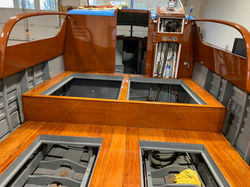 |  |
 |  |  |
 |  |  |
 |  |  |
 |  |  |
 |  |  |
 |  |  |
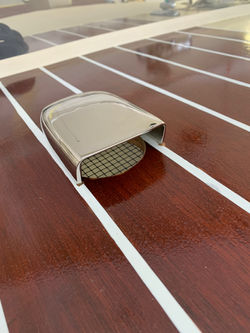 |  |

The Big Sky Chapter of the Antique and Classic Boat Society is pleased to announce Whitefish Woody Weekend XIII. The event, hosted by the Lodge at Whitefish Lake, will take place on June 27-29, 2025, in Whitefish Montana. This is the thirteenth edition of the show which is recognized as one of the premier classic boat shows in the Pacific Northwest. The focus of the show is on having fun using the boats on-the-water and sharing our love of classic boats with the public.
Registration will officially open January 31, 2025. Registration packages will be sent to everyone who is receiving this email and posted on all appropriate websites on that date. Registration is limited to 36 boats on-the-water. As always, registration is on a first come first serve basis. The only way to hold a spot is with a completed registration form and payment of event fees. Registration will fill quickly so submit your registration form and payment as soon as possible after January 31.
Feel free to share this notice with others. If you know of someone who is interested in attending the show who has not received this notice, please have them send an email to whitefishwoodyweekend@gmail.com and I will add them to the mail list before the announcement goes out on January 31st.
I look forward to seeing you all again in June.
BE SURE TO CHECK YOUR EMAIL ON JANUARY 31!!
Tim Salt
Event Director
Whitefish Woody Weekend XII


Spotlight on Spokane Metal Finishing: Excellence in Chrome Refinishing
When I received the latest edition of The Rudder, the first thing that caught my eye was an advertisement for a chrome refinishing company based in Spokane. Intrigued, I reached out to the owner via email to see if they’d be interested in advertising with the Inland Empire Antique and Classic Boat Society (IEACBS). The owner, Kim Degenstein, responded enthusiastically, and we arranged to meet.
Kim Degenstein is the CEO and owner of Spokane Metal Finishing, located at 1519 E. Trent, Spokane, WA, 99202. With over 25 years of experience in chrome refinishing, Kim’s expertise and passion for his craft were evident from the moment I arrived. Spokane Metal Finishing is a professional chroming company specializing in chrome plating, polishing, and repair services. They cater to a wide range of clients, from individuals restoring single parts to those refurbishing entire boats. Their focus on quality workmanship ensures that every project meets the highest standards.
During my visit, Kim gave me a tour of his shop and provided
a detailed explanation of the chrome plating process. Chrome
plating involves a meticulous, multi-step procedure designed
to enhance the appearance and durability of metal products.
The process begins with buffing, polishing, cleaning, and dipping
the metal in acid. Next, zinc and copper plating are added. For
show-quality chrome finishes, the process is even more extensive,
involving re-buffing, cleaning, additional dipping, and layering
multiple types of plating—copper, two to three types of nickel, and finally, chrome plating itself.
Understanding Chrome Plating
We’ve all heard of chrome-plated objects, but many may not realize that these items are not made of solid chrome. Instead, they are coated with a thin layer of chromium through a process known as chrome plating. Chromium (chemical symbol Cr) is a chemical element with atomic number 24 and is a common additive in steel.
Chrome plating serves several purposes. It minimizes wear and tear, increases the lifespan of metal parts, and enhances their resistance to corrosion. It can also reduce friction, prevent galling, and significantly improve the appearance of objects. These benefits make chrome plating a preferred choice for engineering parts and decorative applications alike.
The Electroplating Process
Chrome plating is achieved through electroplating, a technique where dissolved metal cations in an electrolyte salt bath are reduced to form a seamless metal coating on the desired object. The process begins with thorough cleaning to remove dirt or soil from the object. The underlying metal is then pretreated, often through etching, to roughen the surface and prepare it for plating.
Once the object is ready, it is placed into a chrome plating vat. An electric current is applied, allowing the chromium to bond to the metal surface. The current’s strength and the time the object spends in the plating bath determine the thickness of the chrome layer. This precise process ensures a durable and high-quality finish tailored to the client’s specifications.
Spokane Metal Finishing: A Trusted Partner
Spokane Metal Finishing stands out in the industry for their
commitment to excellence and attention to detail. Whether
you need chrome plating for a single part or a complete
restoration project, Kim and his team deliver exceptional
results. Their expertise and dedication make them a
trusted partner for anyone looking to enhance the beauty
and longevity of their metal products.







Have you ever had a boat idea and wondered if this is a good idea but didn't have someone to bounce your idea off? Next time try posting your question to FaceBook under a group that pertains to your project. I have had great success getting answers to my questions. We have several Social Media sites where you keep track of what is going on at the various boat shows plus, there are many YouTube site with valuable information when you are trying to tackle a new project or process. Links can be found at bottom of each page.

Click on the below link to learn more about the history of boat manufacturers
Riva Pietro Riva began building boats in 1842 at Sarnico, a small town in northern Italy on the shores of Lake Iseo. By the 1930s the business was managed by Pietro’s grandson, Serafino. But it was Serafino’s son, Carlo Riva, who transformed the company, making it the worldwide legend it is today. As a young man, Carlo Riva had very different ideas about boat design. Carlo began designing by modifying his father's boats. At 19, Carlo designed his first twin engine boat, and before he was 30, he had designed and built more than 45 different models. Under Carlo’s leadership (which was hard fought), the company produced boats of the absolute highest quality and consistency. A succession of owners have owned the company since Carlo Riva sold it in the early 1970s, and today the firm is owned by the Ferretti Group and produces boats made of fiberglass. According to the Riva Society GB, no one is sure how many of the 4,000 or so wooden boats built by Riva survive today. They are rare and highly collectible.
Gar Wood Garfield A. Wood "never intended to go into the boat building business. His goal was to personally set every speed record on water and be recognized as the world's speedboat king. However, as he set forth to achieve these goals, he was influenced by colleagues and friends and as a result built the world's finest line of production recreational sport boats," according to the Gar Wood Society. Gar Wood produced boats from 1921 to 1947, not including the four years of World War II. It is estimated that over 10,000 Gar Wood boats were built during that period. In fact, for many years Hall’s Boat was a Gar Wood dealership. Today, Gar Wood Custom boats is a family company that builds wooden powerboats " in the tradition of Garfield Arthur Wood himself."
Belmont This company does exist today in Fresno, California. They were founded back in the early fifties and it has been a father-son business for years. They made two or three luxury runabouts starting in 1956 until 1966 then converted to all fiberglass flat bottom jet boats until 1985.What is unique is that they were one of the first companies to fiberglass their boats below the waterline over the marine plywood. They would hold 8 passengers and would roar across the lakes and seas at 60 plus miles per hour.The old shop which is now called Belmont Marine is still in Fresno, CA and was bought from the son, Lynn Weeks. Founder Smitty Weeks passed away years ago at the age of 93.According to a former employee, Brent Rim at Belmont Boats, "We were mostly building jet boats. Smitty had designed a custom v-bottom hull using the 19' flat-bottom as a template. He actually got it patented. It was the fastest stock boat using the Berkeley 455 Olds Pack-a-Jet power unit. He also retrofitted the design into a 21' luxury day cruiser. While I was there, a guy named Simon did all the fiberglass work out back, and I did the hardware installations along with a guy named Bob. Lynn would stop by periodically. The most awesome part of that job was listening to the many stories Smitty told us based on his years of custom boat building and racing. There were many photos around the shop of his old wood boats, including one that resembled a shark and many custom wood inboards that he built for clients at Lake Tahoe. The most famous Belmont might be the Purple People Eater which was the first drag boat to run over 100 mph in the quarter mile and reached a top speed of 115 mph with Allison power at Fremont California in 1961.
Chris Craft One of the most widely recognized names in wooden motorboats, Chris-Craft got its start in 1922 in Algonac, Michigan, with Chris Smith and his sons Jay and Bernard at the helm. Chris led several boat building ventures prior to that, including a partnership with Gar Wood building race boats. Chris-Craft focused on standardized boat production, enabling them to build boats year-round and at a good profit - while still being affordable to the average guy. Chris-Craft's boat lines included the runabouts, utilities, cruisers, and sea skiffs. The founders sold the company in 1960, but Chris-Craft continued building wooden boats until 1972. The company is still around today, building boats made of fiberglass.
Lyman Bernard and Herman Lyman, brothers from Cleveland, Ohio, started building boats in the late 1800s. Their boats were designed and built to handle the powerful chop of Lake Erie. Lyman Boats quickly established a regional reputation for quality lapstrake rowboats and sailboats. In the 1970s, the company turned to fiberglass production and by 1980, Lyman had stopped new boat production entirely. By 1988 the new owner of Lyman reached out to Tom Koroknay, a Lyman enthusiast and restorer who ultimately purchased the wood boat patterns, jigs, tools, hardware and even the plans and archives dating back to the original days of the Lyman brothers remained, which included drawings, half models, racing trophies, and hull records. Today Koroknay, known affectionately as Doc Lyman, operates Koroknay's Marine Woodworking/Lyman Boats in Lexington, Ohio.
Century The Century Boat Company built some of the pleasure boating most talked about styles. The company was founded in Milwaukee in 1926. It began by building fishing boats, sailboats, canoes, and the champion racing outboards. Century soon moved to its home of the next 60 years, Manistee, Michigan. There they added mahogany runabout inboards, and even challenged the small inboard race classes with the 14-foot Thunderbolt. Struggling through the lean years of the depression, Century offered a wide variety of finely crafted, 15- to 20-foot runabouts, utilities, and outboards. During World War II, the company supplied over 3,500 small assault boats -- a dedication that earned the defense department's Army-Navy "E" flag. In contrast to the decline experienced by noted wood boat producers at the time such as Gar Wood and Hacker, Century enjoyed a period of unprecedented prosperity after the War. The company immediately began production of the popular Sea Maid model and introduced the highly versatile utility type Resorter shortly thereafter. In 1955 the company introduced both the Coronado and the Arabian. Cadillac and Chrysler V8 engines were also added to the line-up. The new models of the '50s, the Coronado, Arabian, Viking, and Palomino, boldly incorporated the stunning design trends of the automobile industry from that time. A well-restored Century from that era is highly collectible. Today, the Century Boat Company is based in Florida and produces fiberglass boats.
Stancraft StanCraft was founded in 1933 by W.H. "Billy" Young and his son Stanley Young, when they handcrafted their first mahogany wood speedster in Lakeside, Montana, on the shore of Flathead Lake.Over the next 35 years, they constructed over 800 wooden boats, with Stanley Young as head designer and builder. In 1937, when StanCraft built its first factory near Somers, Montana, it was the only boat-building factory in Montana.[4] Stanley and his brother Donald Young operated the factory until the beginning of World War II, and resumed operations after the war. During the war, Stanley operated a plant on the West Coast, building boats for the US Coast Guard. In 1948, StanCraft's sales offices and headquarters were moved from Somers to nearby Polson, Montana.On March 9, 1966, a fire burned down the StanCraft manufacturing plant in Somers, destroying 11 boats that were in storage. Stanley Young and his wife Delores had three children, including Syd Young,who took over the business in 1970. As fiberglass boats grew in popularity, the company began building fiberglass boats in addition to wooden boats. Syd Young moved the company to Coeur d'Alene, Idaho, in 1981. The company's main business at the time was restoring wooden boats, building only a few new boats per year. The 1981 film On Golden Pond, which features vintage wooden boats, was credited in part with sparking renewed interest in the vessels. In 1997, Syd Young cut back on operations and sold much of the company's assets to Hagadone Marine Group. Robb and Amy Bloem (Billy Young's great-granddaughter) took over what remained of StanCraft in 2003, rebuilding the custom manufacturing operations while expanding the company's storage and restoration services and adding three brands of fiberglass boats to its offerings
Shepherd The Shepherd Boat company was a small semi-custom builder of wooden boats, somewhat understated in styling but of high quality. The company was established in Ontario, Canada after World War II, initially selling boats only in Canada. In 1949, Shepherd introduced its first boat for sale in the US – a 17-foot twin cockpit forward model runabout. Its American distributor, Jafco Marine Basin of Buffalo, NY marketed the Shepherds heavily in the US, and the boats gained in popularity. By 1953, Shepherd was producing five models, including a convertible express cruiser, an 18-foot V-drive runabout, an 18-foot direct drive utility, and the Seamaster Twenty – a "roomier and stauncher 20-foot utility that can ship a he-man cargo of luggage, camp gear, or provisions . . . [with the] grace and agility of a runabout" as exclaimed by its advertisement in January 1954 Motor Boating magazine. In his book The Real Runabouts I, author Bob Speltz notes, "Shepherd did not switch from wood [to fiberglass] as most other inboard builders did and it seemed by 1960, the wooden inboard runabout market had all but dried up." And with that, so did the Shepherd Boat company. Speltz goes on to say, "Today, Shepherd runabouts are gaining favor nationwide with collectors. It is hard to find a better constructed or nicer equipped speedboat than a Shepherd!"
Hacker Craft John Hacker was a design artist with a knack for what made a boat go fast. In fact, over the course of his life, John Hacker also designed boats built by other firms. Hacker bought his first boat works in 1909, and within the first three years had built nearly 30 hydroplanes, including some that could go over 50 mph. In 1913 Hacker joined with L.L.Trip and formed Hacker Boat Company, which later became the Albany Boat Co. After a short period Hacker sold the company and then started the Hacker Boat Company again, this time in Michigan. Throughout the 1920s, John Hacker and his company built luxury speedboats, including one in 1923, initially named "Miss Mary" and later renamed "El Lagarto." "El Lagarto" made racing history when she was repowered with a 300-horsepower Packard engine by George Ries and won the 1933, 1934 and 1935 Gold Cup Race. Today, "El Lagarto" is on permanent display at the Adirondack Museum in Blue Mountain Lake, NY.The characteristic and highly innovative Hacker bottom had concave sections the entire length of the boat—a departure from other bottom designs of the day from Chris-Craft and Gar Wood. This bottom shape gives the Hacker Crafts an inspiring, solid feel in the water, along with great speed. The construction of the original Hackers had many refinements, from using rivets to fasten the planking to the intermediate frames, as well as using forgiving red cedar for the longitudinal, outer planking below the waterline, rather than hard mahogany. By the 1930s, Hackercraft was under new ownership but the commitment to building high quality boats was going full strength. The 30s saw a full lineup, including a 42-foot twin engine cruiser and the popular 24-foot and 25-foot triple cockpit runabouts. Those 1930s runabouts are characterized by their long decks, 3 piece windshields, and lots of chrome. By the 1960s, the company was defunct. The Hacker Craft name was re-started on Lake George in the 1980s by Bill Morgan, and even today you can buy a modern, wood epoxy version of these classic boats. than a Shepherd!"
Ventnor 2002 marked the 100th Anniversary of Ventnor Boats. Adolph E. Apel first established his company in Ventnor, New Jersey. His vision was to build boats that would successfully adapt the gasoline engine as the predominant source of lightweight, efficient, and fast power. As in early automobiles, gasoline engines had to be proven to the public to have virtues of speed, endurance, and reliability. Adolph was an excellent mechanical engineer, and chose his commercially built power well. His ability to adopt new hull designs of lightweight yet durable construction was proven in his successful involvement with inboard racing. Ventnor boats continuously updated their designs, as lighter and greater horsepower engines became available. A 1913 example was Tech Jr., built for T. Coleman Dupont which was the worlds first recorded boat to exceed the over a mile-a-minute (60.3 MPH) mark. The Ventnor Company built a wide variety of custom launches, tenders, utilities, runabouts, and commercial small craft into the 1930s. Their racing involvement remained strong, and the 1931 American Power Boat Associations (APBA) creation of a 135 cubic inch displacement racing class was immediately dominated by Ventnor. The Flying Eagle set the 1931 speed record of 35.7 MPH, and in the succeeding years of the 1930s, the 135 class records were held by Ventnor at 54.08 MPH lap speed, and 67.5 MPH flying mile. In 1934, the APBA introduced the 225 class, and Ventnor set a record of 44.14 MPH. Later in the 1930s, Ventnor set the record at 66.4 MPH lap speed, 87.5 MPH flying mile. Ventnor boats, privately owned and raced, held virtually all records in the 91, 135 and 225 cu. in. classes, as well as many divisional and national championships. Adolph Apel invented the five-point suspension hull in 1935, and refined it to the three-point style. He patented the three-point suspension hull in 1936 in the US and UK, and it is still used today.
Goto this site and give it a try by clicking on the Salty Sailor
What is my boat worth? The Marine Division at Hagerty can help. You can access the Hagerty Valuation Tool using this link, Visit Hagerty


_edited_edited.jpg)






